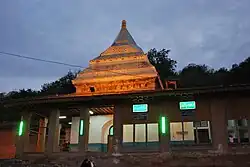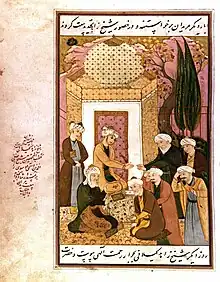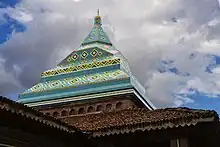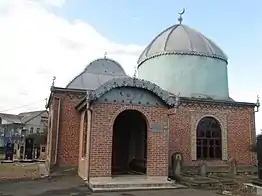| Tomb of Shaykh Zahed Gilani | |
|---|---|
 The mausoleum during the evening hours | |
| Religion | |
| Affiliation | Twelver Shi'a |
| Province | Gilan |
| Location | |
| Location | Lahijan, Iran |
 Shown within Iran | |
| Geographic coordinates | 37°12′06″N 50°02′47″E / 37.2015451°N 50.0463754°E |
| Architecture | |
| Type | mausoleum |
| Style | Safavid |
| Completed | 15th century |
| Materials | wood, brick |
The Tomb of Shaykh Zahed Gilani (Persian: آرامگاه شیخ زاهد گیلانی) or Sheikhanvar[1] is a historical mausoleum in Lahijan, Iran. It dates back to the Safavid era.[2] This mausoleum is the purported burial place of Zahed Gilani, a 13th-century Sufi mystic and the forefather of the Zahediyeh and Safaviyya Sufi orders, which would eventually evolve into the religion of the Safavid Empire. The mausoleum is the 824th national monument of Iran.[3][1]
History

Zahed Gilani died in 1301, during the early 14th century. The mausoleum was built in the late 15th century, presumably around 1480–1499, and it was renovated during the early Safavid era.[3][2] Local tradition and folklore relates that the mausoleum's construction was ordered by Shaykh Haydar after he received an incomprehensible dream during his sleep.[3] During the Qajar era, the walls were decorated extensively with tiles.[2]
Architecture
The mausoleum is constructed primarily out of wood and brick.[2] It is rectangular in shape, and has a porch in front of it.[2][3]

The dome of the mausoleum is in a unique, pagoda-like style.[2][3][1] It is decorated with turquoise tiles.[2][3] It has eight layers as well. The steep slopes on this dome allows rainwater to flow off smoothly.[3][2][1]
Inside the mausoleum, there are two rooms. The square-shaped room underneath the dome holds the tomb of Zahed Gilani.[3][2] The second room, more rectangular, holds two tombs.[2][3] One of the tombs is dedicated to a religious cleric, Seyyed Razi ibn Mahdi al-Husseini, while the other tomb belongs to one of the daughters of the founder of the Timurid dynasty, Tamerlane.[2][3]
Other tombs

In the city of Lankaran in Azerbaijan, there is another tomb which is attributed to Zahed Gilani.[4][5] Some do not believe that the site in Lahijan is the actual burial place, and regard it as merely a symbolic tomb[2] or the burial place of a similarly named mystic.[2]
See also
References
- 1 2 3 4 "Sheikh Zahed Gilani's Shrine is one of the national monuments of Iran". IRAN Paradise. 2021-03-06. Retrieved 2023-11-29.
- 1 2 3 4 5 6 7 8 9 10 11 12 13 Iran, Reisen (2020-11-19). "آرامگاه شیخ زاهد گیلانی". سایت گردشگری سفر در ایران (in Persian). Retrieved 2023-11-29.
- 1 2 3 4 5 6 7 8 9 10 "آرامگاه شیخ زاهد گیلانی - مجله مِستر بلیط" (in Persian). 2019-02-20 [نوشته شده در 20 بهمن 1399]. Retrieved 2023-11-29.
- ↑ Serap Şah, Safvetü's-Safâ'da Safiyyüddîn-i Erdebîlî'nin hayatı, tasavvufi görüşleri ve menkibeleri, Doktora tezi, Marmara Üniversitesi Sosyal Bilimler Enstitüsü / Temel İslam Bilimleri Anabilim Dalı Tasavvuf Bilim Dalı, İstanbul 2007, s. 30-31, s.66, s.340
- ↑ Şeyx Səfi Təzkirəsi. Səfvətüs-səfanın XVI əsr türk tərcüməsi. Bakı: Nurlan, 2006, s. 135